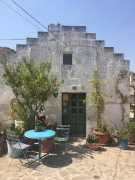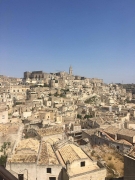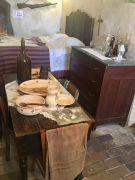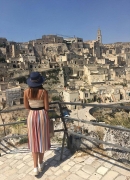by Giovanna Fusco
Sometimes I think Italy is a small jewel that often does not really know the value, or rather, of which you often do not know how to appreciate the beauties. So this year, among my goals, I chose another place I would have long wanted to go to, Matera.
This city always fascinated me for what I had seen, the landscape, the glimpses, because at sunset it assumes the appearance of a crib, for white houses that from any angle appear unique.
I went to August and as if that was not enough, I started exploring the country at eleven o’clock in the morning. You think it’s a crazy and maybe I believe it too, buti t was one of the luckiest madness I’ve ever had! The sun was hot, buti t illuminated every corner of the city and I did not have much time available; we turned to a tourist agency almost uncovered by chance, buti t was just the case to make me appreciate Matera, thanks to a guide among the best I’ve ever met: Maria Pia Albano. What about you guys, I think I had more information that morning than if I had bought ten books.
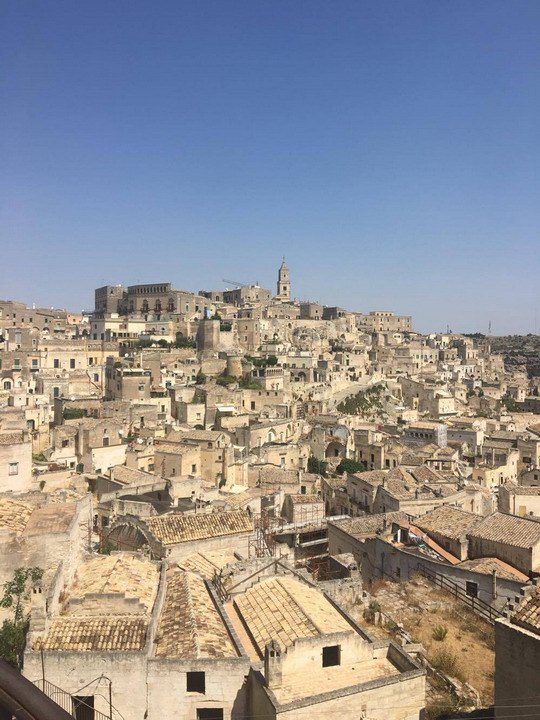 But let’s get to us! As we know, Matera is a common Italian capital of the province of the same name and the second city of Basilicata for population, known worldwide for the Sassi, recognized on December 9, 1993, at the Cartagena de Indias Assembly, World Heritage Site UNESCO. The Sassi, as one would commonly think, are not simple stones; excavated and constructed close to the Gravina di Matera, a gorge that divides the territory into two, consists of two large Rioni: Sasso Barisano and Sasso Caveoso. The city is rich in rock churches, carved in the rock, each with its own peculiarity and uniqueness, to be seen absolutely once there. Among the most important are the Chiesa Santa Madre de Idris, Santa Lucia alle Malve, San Pietro Barisano, which testify to the evolution of man from prehistoric phases to Christianity. I advise anyone to walk smoothly, listening to silence and contemplating, getting into the narrow alleys, because every glimpse is striking.
But let’s get to us! As we know, Matera is a common Italian capital of the province of the same name and the second city of Basilicata for population, known worldwide for the Sassi, recognized on December 9, 1993, at the Cartagena de Indias Assembly, World Heritage Site UNESCO. The Sassi, as one would commonly think, are not simple stones; excavated and constructed close to the Gravina di Matera, a gorge that divides the territory into two, consists of two large Rioni: Sasso Barisano and Sasso Caveoso. The city is rich in rock churches, carved in the rock, each with its own peculiarity and uniqueness, to be seen absolutely once there. Among the most important are the Chiesa Santa Madre de Idris, Santa Lucia alle Malve, San Pietro Barisano, which testify to the evolution of man from prehistoric phases to Christianity. I advise anyone to walk smoothly, listening to silence and contemplating, getting into the narrow alleys, because every glimpse is striking.
On October 17, 2014 Matera was named European Capital of Culture for 2019. A culture born of suffering: the Sassi of Matera have a fascinating but tormented story, made of privations and difficulties. By strolling the visitor will find in every corner of the hypogea, churches, caves, the same caves that until the 1960s were inhabited by people on the margins of society, who lived in miserable, absurd conditions for citizens of the twentieth century. “The Sassi, therefore, is not to be photographed with a simple photographic machine,” says Maria Pia, “is not enough, it is not fair: I have to immortalize with my mind and my heart, I have to contemplate, because there lives the man who has been a victim of suffering and unimaginable atrocities.”
Walking is impossible to ignore the uniqueness of the place, as it is not right to not understand it from the human point of view. During our journey we stopped at a point that at first glance seemed bare, insignificant, but it turned out to be the most important place of all our “journey”: Maria Pia, opening her heart, revealed to us the real sense of that place, a cave now closed but untile the ‘70s was inhabited by families who lived there, without water, with nothing, along with a donkey, who, however, made them company and was a companion of work and life. They were the most humble, the laborers, the real architects of this, not the graduates, not the doctors, not the lawyers, no. Everything in Matera tell us of misery, suffering, humiliation of the human being, but also of beauty, charm, culture in the highest sense of the term. At the heart of everything, all we could think of, true value lies in the soul, in the ability to create non-caves but cultural patrimony. I agree with Maria Pia when she believes with convinction that culture is the exclusive product of human thought.
From there we went to admire the cisterns, as Matera has a very low rainfall, and the water supply was one of the biggest problems the mattresses have had to face, and you know who has remedied? The man, the simple and humble one, the farmer, the craftsman, who with the “intelligent heart” managed to solve problems and discover genious solutions.
I choes to visit this fascinating and painful city, but I did not think I would be so enchanted by the cultural richness of which it is carved, with the hidden meaning behind every corner of the city, with breathtaking beauty. Behind Matera there is something else, there is everything that matters to us: there is life!
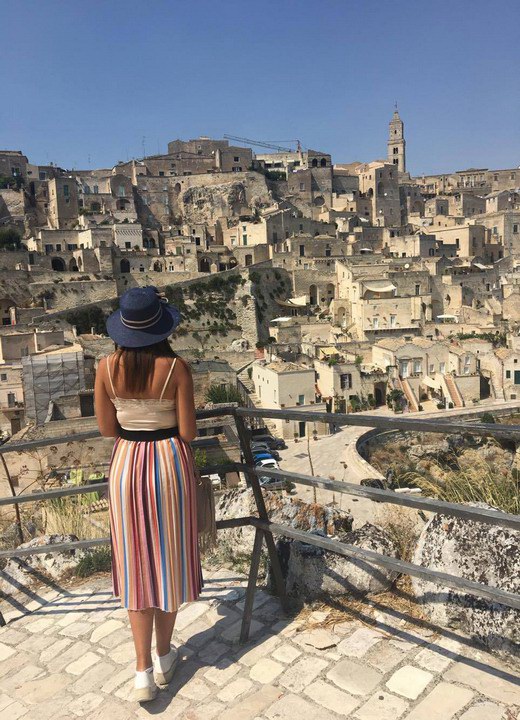 A special thanks to Maria Pia, without which I could not admire with my eyes and with the soul a unique marvel in the world.
A special thanks to Maria Pia, without which I could not admire with my eyes and with the soul a unique marvel in the world.



